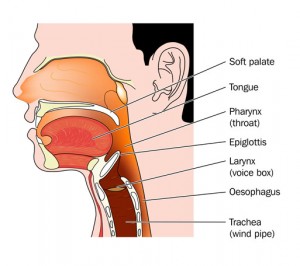Obstructive Sleep Apnea – The Anatomy.
When discussing why sleep apnea occurs it is important to understand some of the anatomy of the throat and the airways.
The air we need gets into our bodies through the airways of the mouth and nose. The air then goes down through the pharynx (throat) into the trachea (wind pipe), and from there into the lungs. The reverse is true when we breathe out.
Normally this is not an issue, but in sleep apnea there are blockages to this easy movement of air. This is usually due to the muscles of the throat relaxing as we sleep, causing the throat to collapse, as well as the tongue falling backward and blocking the airway. In addition, if you are overweight this places extra pressure on the throat causing it to collapse more easily. This is obviously worse when you are lying on your back, as gravity makes it easier for the tongue and palate to fall backward blocking or reducing the size of the airway.
This blockage then means that you cannot get the air into your lungs like you should. As a result your blood levels of carbon dioxide starts to rise. This increases the amount of drive that your brain sends to the breathing muscles, and at the same time starts to wake you up. Eventually the brain sends enough drive to the breathing muscles to overcome the blockage, usually with a snort or splutter, and you get the air into your lungs. However the process repeats time and time again, and each time you get woken from your deep sleep into a shallow, less refreshing sleep.
Why does this happen?

The anatomy of the throat relevant in sleep apnea
The frontal lobes are the areas at the top and front of the brain. As one of their many functions they contribute to the resting tone of muscles in the body. Resting tone is also influenced by the cerebellum. Dysfunction or decrease in activity in either of these two areas will lead to a decrease in muscle tone in the body.
Now when you are asleep, the activity in your frontal lobes decreases and you aren’t getting the same amount of activity in your cerebellum either. This will mean that the activation going to the muscles will become less also. As a result their tone will decrease, that will mean they will become more floppy. This is normal.
Now for some people that isn’t a problem because the tone (that is the activity in their brain) was fairly high to start with, so when they decreased their activity in sleep there was enough tone left over to keep the airway open. However some people are lacking sufficient tone in the muscles to start with and with the decrease in brain activity they don’t have enough tone to keep the airway fully or even partly open. So one of the aims of a sleep apnea exercise program should be to increase the levels of activity in your frontal lobes, your cerebellum and the brainstem areas where the nerves to the throat muscles come out. This will help address the causes of sleep apnea rather than just the symptoms.


